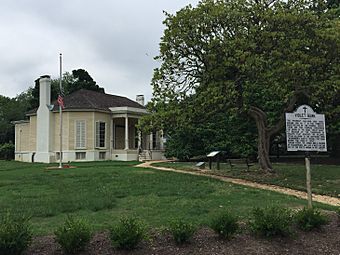Violet Bank Museum facts for kids
Violet Bank is an old house and museum located in Colonial Heights, Virginia. It's a special place because it was added to the National Register of Historic Places in 1974, meaning it's important to American history.
Contents
History of Violet Bank
Early Days and the Revolutionary War
The story of Violet Bank began in 1777. A man named Thomas Shore bought 144 acres of land on a spot called "Archers Hill." He finished building the first house there in 1778.
This first house was important during the American Revolutionary War. In 1781, General Gilbert du Motier, marquis de Lafayette used Violet Bank as his headquarters. This was at the start of a big military plan in the South. This plan eventually led to the British General Cornwallis giving up at the Siege of Yorktown.
Two battles happened on the hillside near Violet Bank during the war. The first was in March 1781, led by General Friedrich Wilhelm von Steuben. The second was in April 1781, led by General Lafayette. Both battles were against British Major General William Phillips.
General Phillips wrote about the property in a message. He said his troops tried to take the high ground near Thomas Shore's house. But they were pushed back and lost about 200 soldiers. Phillips wanted to control the river crossing and a main road in Petersburg. This road was key for moving troops and getting supplies.
Phillips later became sick and died. He was buried in an unmarked grave so that the American rebels wouldn't disturb his resting place. He was one of the highest-ranking British officers buried outside Great Britain. After Phillips died, Cornwallis took command. Since he couldn't defeat Lafayette, Cornwallis decided to leave Virginia.
Changes to the House Over Time
General Lafayette visited Violet Bank again in 1824. This was his last visit to the United States as an official guest. The house looked very different by then. In 1796, it was described as a two-story wooden house with a cellar kitchen. It looked a lot like another old house called Weston Manor.
In 1810, the house caught fire, supposedly when the family was at church. Thomas Shore had lived in the house for 22 years until he died in 1800. He left behind his wife, Jane Grey, and three young daughters. Jane Grey remarried in 1804 to Henry Haxall. They and the girls were living there when the fire happened. The cellar kitchen was likely where the fire started.
Luckily, the chimney stacks and foundation of the house survived the fire. This was unusual because the mortar used back then often couldn't handle such intense heat.
Rebuilding and New Designs
From 1810 to 1815, the house was rebuilt. The front foundation was changed, and a completely new main house was built on top of the old foundation. It's thought that famous architect Benjamin Latrobe, or one of his students, might have designed the new Violet Bank. Latrobe had visited Petersburg in 1796 and knew Thomas Shore.
Many historians believe a student of Latrobe's designed Violet Bank. It has features like octagonal (eight-sided) sections and a special entrance area. These features were common in Latrobe's work. Henry Haxall and Jane Grey were wealthy enough to hire a top architect like Latrobe.
The architect had to work with the parts of the house that survived the fire. This made the design unique. For example, the second floor was removed, which allowed the ceilings to be made taller. The outside brickwork was covered with stucco to make it look smooth and hide the changes.
Later Owners and Becoming a Museum
Henry Haxall died in 1834. The house then passed to the Gilliam family, who were related to Thomas Shore. Violet Bank stayed with the Gilliams until 1873. During the American Civil War, part of the main house was used as a hospital.
The war made the Gilliam family poor, so they sold the house in 1873. It was bought by Mrs. Evelyn Gasquet Marshall, a cousin. After she died in 1885, Captain Abel N. Haskins bought the property. His family later sold the house and 68 acres of land in 1905 to a company called Greater Petersburg Realty Corporation.
The new owners used Violet Bank as a dairy farm. They even knocked down walls on the first floor to use it as a cattle barn! In 1914, the company decided to divide the farm into smaller lots for housing. They tore down a large part of the main house, leaving only the section we see today.
The smaller Violet Bank was one of the first houses sold in the new neighborhood. Mrs. Alice Pierrepont bought it in 1919 and lived there until 1948. Then, the American Legion Post 284 bought it. In 1959, the City of Colonial Heights bought the house. It was first used for the Chamber of Commerce, and then as Colonial Heights' first public library.
Violet Bank was added to the National Register of Historic Places in 1974. Since 1988, it has been an active Historic House Museum. It shows what Federal-style design and American decorative arts were like in the past.
See also




